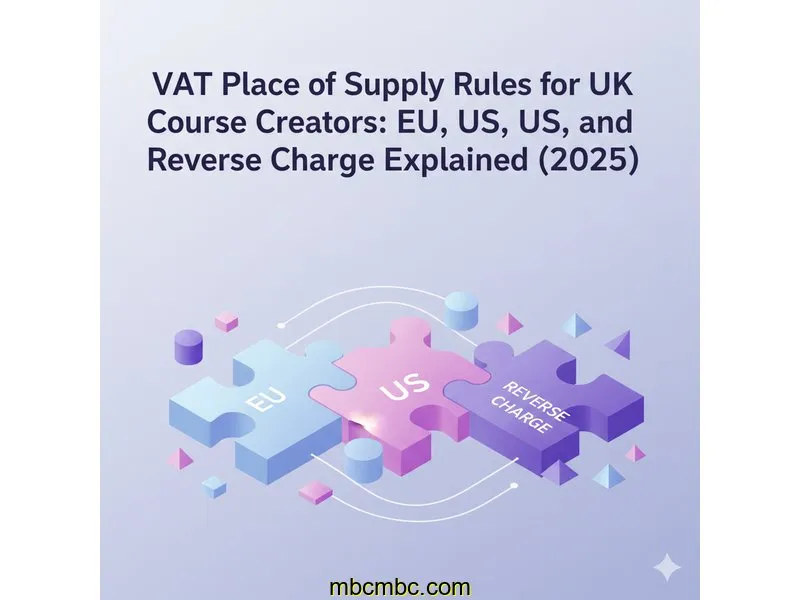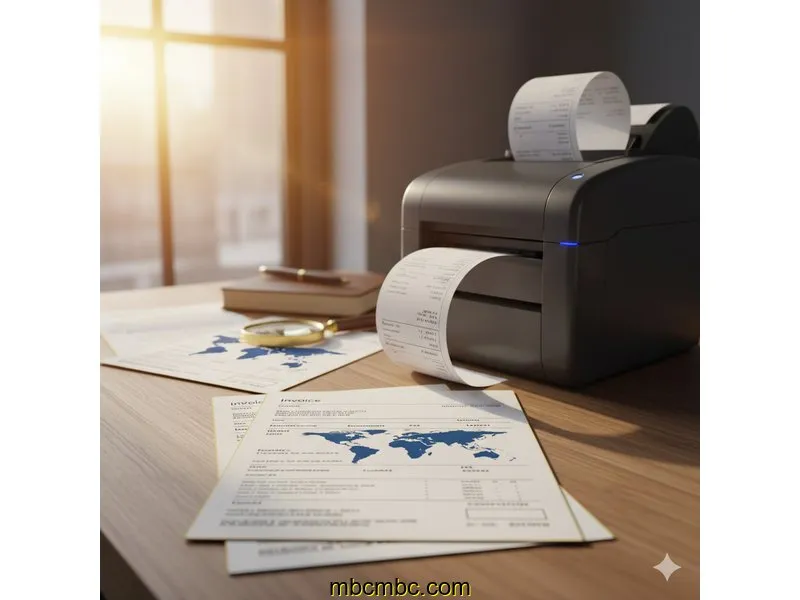
Picture this: You’re a UK-based online course creator—a coach, a digital marketer, or a fitness instructor—and you just had a great month. Your sales come from Bristol, Berlin, and Boston. You’re staring at your profit and loss, trying to figure out the single most confusing tax question for digital entrepreneurs: **Do I charge UK VAT, EU VAT, or no VAT at all?**
If you've felt this confusion, you are definitely not alone. The VAT place of supply rules for digital services are complex because the service (like an e-book or a membership) is consumed where the customer is, not where you are based. Getting this wrong isn't just a simple mistake—it can lead to serious **HMRC penalties** and unexpected registration requirements in EU countries. Since Brexit and the evolution of the EU's One-Stop-Shop (OSS) system, the grey areas have multiplied, leaving many UK freelancers and small business directors struggling to comply. This guide, based on current HMRC guidance for 2025, aims to cut through that complexity and provide a clear framework for your business.
Key Takeaways
- B2C Rule: For digital services sold to EU **consumers** (B2C), you must charge the VAT rate of the customer's country, regardless of your UK VAT registration status.
- B2B Rule: For digital services sold to EU **businesses** (B2B), the **Reverse Charge** mechanism usually applies, meaning you charge 0% VAT.
- Key Data Point: HMRC data reveals that the VAT compliance gap for small businesses is growing, with incorrect cross-border VAT accounting being a major factor for errors (HMRC, 2024).
- When to Act: If you sell *any* automated digital product (like an e-book or pre-recorded course) to an EU consumer, you need to register for the Non-Union One-Stop-Shop (OSS) system or use an intermediary.
- Disclaimer: This article provides informational guidance based on HMRC rules as of November 2025. It is not financial or legal advice. VAT rules are complex and penalties for errors are significant—always consult a qualified accountant for your specific situation.
The 'Place of Supply' Rule: Where Does Your Digital Service Sit?
The core concept governing your VAT obligations is the **Place of Supply** rule. Think of it like this: for a physical product (like a book), the place of supply is clear—it's where the book is handed over. For digital services—which HMRC defines as anything delivered over the internet, like e-books, online courses, software, or web hosting—the rule is counterintuitive: **the supply takes place where the customer is located.**
This single rule is what eliminates the UK’s usual £90,000 VAT threshold for your B2C digital sales into the EU. You owe VAT in the customer’s country from the very first sale. This matters because getting it wrong can lead to serious compliance issues. The EU requires you to collect at least two pieces of non-contradictory evidence to prove your customer's location, such as billing address, IP address, or bank account location (HMRC VAT Notice 741A, 2025).
Scenario-Based VAT Breakdown: B2C, B2B, and International Sales
To make sense of the place of supply, you need to first ask: is your customer a business or a consumer? Is the customer in the UK, the EU, or the rest of the world? The answers dictate your entire VAT process. To see this in action, let's break down the four most common scenarios UK digital course creators face. The table below shows exactly whose VAT rules apply and what you need to charge in each case.
| Customer Scenario | B2B or B2C? | Whose VAT Rules Apply? | What You Charge | What You Must Do |
|---|---|---|---|---|
| UK consumer buys your £100 e-book | B2C (Business to Consumer) | UK | UK VAT at 20% (£20) | Charge £120 total. Pay VAT to HMRC via your standard VAT return (if UK VAT registered). |
| German hobbyist buys your £150 course | B2C | EU (Germany) | German VAT at 19% (£28.50 approx) | Charge customer German VAT. **Register for EU VAT via the UK Non-Union OSS system.** Pay Germany via your OSS return. |
| French company (with VAT number) buys your £500 corporate training license | B2B (Business to Business) | EU (France) | 0% (Reverse Charge applies) | Do NOT charge VAT. Verify their VAT number on the EU VIES system. They account for VAT in France. |
| Australian consumer buys your £75 template | B2C | Australia | None (Outside UK/EU VAT scope) | Do NOT charge UK or EU VAT. Note: You may be required to register for GST in Australia if sales exceed a certain threshold (AUD $75,000), a rule that requires separate compliance. |
As you can see, the same £100 digital product can trigger three completely different VAT treatments depending on the customer's location and status. This is why a generic "just charge 20% VAT" approach is a compliance disaster waiting to happen. The distinction between B2B and B2C is critical: for B2B sales in the EU, the liability shifts to the customer (the Reverse Charge mechanism), but for B2C sales, the liability stays with you.
The Non-Union OSS System: Your VAT 'Post Office'
If you sell B2C digital services to EU consumers, you need a way to collect and pay the VAT in 27 different member states. Before 2021, this required registering for VAT in every single country where you sold services—a massive administrative burden. Thankfully, the EU introduced the One-Stop-Shop (OSS) system, which you can think of as a VAT "post office."
Since the UK is no longer an EU member, you register for the **Non-Union OSS** scheme. This is a crucial simplification: it allows you to report and pay all the EU VAT you collect on B2C digital sales via a single quarterly return submitted to a single EU tax authority (usually Ireland, as the first country you sold to). This simplifies the process dramatically and is key to compliance for most digital course creators. Interestingly, in 2023, the total value of digital cross-border trade reported via the Non-Union OSS scheme exceeded €50 billion (European Commission, 2024).
Step-by-Step: Registering for EU OSS as a UK Digital Seller
1. Check Eligibility: You must be a non-EU established business (which you are as a UK seller) and selling electronically supplied services (ESS) to non-taxable persons (consumers) in the EU. Importantly, you **do not** need to be UK VAT registered to use the Non-Union OSS system; the UK VAT threshold of £90,000 does not apply to this scheme.
2. Apply in a Member State: You register for the scheme in one EU member state, which then becomes your 'Member State of Identification.' This is often the first country where you made an EU sale. That country’s tax authority becomes your single point of contact for all 27 returns.
3. Charge the Correct EU VAT Rate: You must charge the correct VAT rate for the consumer's country. Rates range from the standard 20% in France to 27% in Hungary—it is your responsibility to know and apply the right rate. This information is typically updated annually by the European Commission.
4. Submit Quarterly OSS Returns: You file a single quarterly return through your Member State of Identification, listing the sales and VAT due for each EU country. You then make one payment to that single tax authority.
Edge Cases: The 'Human Intervention' Test and Live Services
The rules above apply primarily to **Electronically Supplied Services (ESS)**, which are automatic, low-human-touch services like downloading an e-book, streaming a pre-recorded course, or accessing a membership area. But what about services that involve a human element?
One question that comes up frequently is: **What if you’re selling a 'live' service like 1-to-1 coaching via Zoom?** This is where the **Human Intervention Test** comes into play. HMRC’s guidance clarifies that services requiring significant human intervention—such as live, interactive one-to-one coaching sessions, live webinars where the audience interacts with the presenter, or consulting—are generally **NOT** considered ESS (HMRC VAT Notice 700/1, 2025). Instead, they are usually considered to be supplied where the recipient (the customer) belongs. This often means they fall under the general B2B and B2C place of supply rules for services, which can be simpler: for B2B, the Reverse Charge applies; for B2C, UK VAT applies if you’re a UK-based supplier, provided you are below the £90,000 threshold or are already UK-registered. If you mix the two—selling a recorded course *and* live coaching—you must separate the sales and apply the correct VAT rules to each component.
Common Questions About Digital Service VAT
Based on questions I’ve seen across UK freelancer forums and Reddit’s r/UKPersonalFinance, here are the three most common points of confusion that trip up digital sellers.
If my business isn't UK VAT-registered, do I still need to worry about EU VAT?
Yes, you do. The UK’s £90,000 VAT threshold is for UK domestic sales. Since the Place of Supply rule for B2C digital sales is the customer's location (the EU), your obligation to charge EU VAT starts from the very first sale to an EU consumer. You register for the Non-Union OSS system regardless of your domestic UK VAT status. You must keep detailed records for 10 years to prove the customer's location.
A customer in Belgium bought my e-book but paid with a UK bank card. Which country's VAT applies?
The crucial factor is the customer's **location**, not the bank card used. The EU requires two non-contradictory pieces of evidence to prove the location: this might be the billing address, the IP address, or the country code of the SIM card. If you collect two pieces of evidence that point to Belgium, you charge Belgian VAT via OSS, even if the payment method is UK-based. If the evidence is contradictory (e.g., Belgian IP but UK billing address), you may have to follow a tie-breaker rule in the OSS manual, but the core principle is that the place of consumption determines the VAT.
Do I need to charge VAT on digital services sold to customers in the USA, Canada, or Australia?
For most UK course creators, sales to non-UK/non-EU consumers (like the US) are outside the scope of UK and EU VAT and are therefore zero-rated. You do not charge VAT. However, the USA, Canada, and Australia each have complex sales tax (or GST) rules. If your sales in any one of those countries exceed a local threshold, you might be required to register for that country's local sales tax. For the US, this is dictated by 'economic nexus' laws that vary by state, meaning high volume sellers might need to comply with multiple state sales taxes.
Conclusion: Your Next Steps

Understanding UK VAT on digital services comes down to three core principles: **know your customer's location**, **distinguish B2B from B2C**, and use the correct system (UK VAT, EU OSS, or Reverse Charge) for each scenario. For most UK digital course creators, the complexity stems from the fact that B2C sales to the EU trigger an instant tax obligation in 27 different countries, requiring the use of the Non-Union OSS system to simplify compliance.
If you're a UK freelancer or director selling digital products internationally, start by auditing your sales platform (e.g., Stripe, PayPal, or specific e-course platforms) to confirm the location data you are collecting. This data—the two pieces of evidence required by the EU—is your first and best line of defence in an HMRC inquiry. For most sellers, the OSS system simplifies EU compliance dramatically, but you must correctly identify the VAT rate for each country, which requires careful record-keeping. However, VAT rules are intricate and penalties for errors are severe—this guide provides a framework, but for your specific business setup, always consult a qualified VAT accountant who understands cross-border digital sales.

